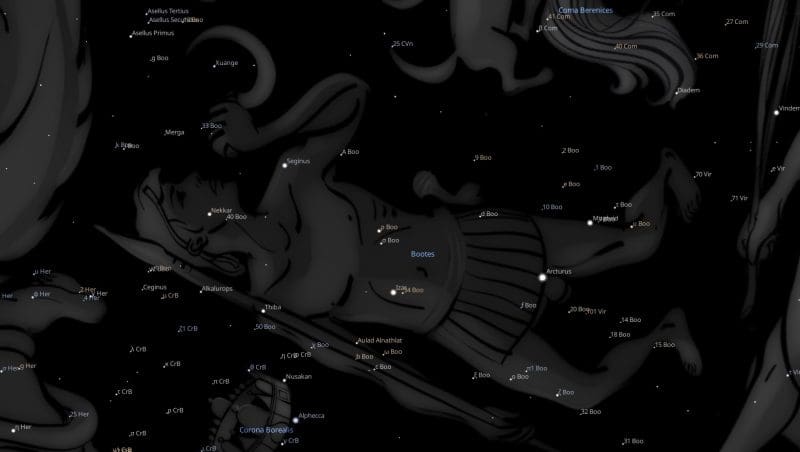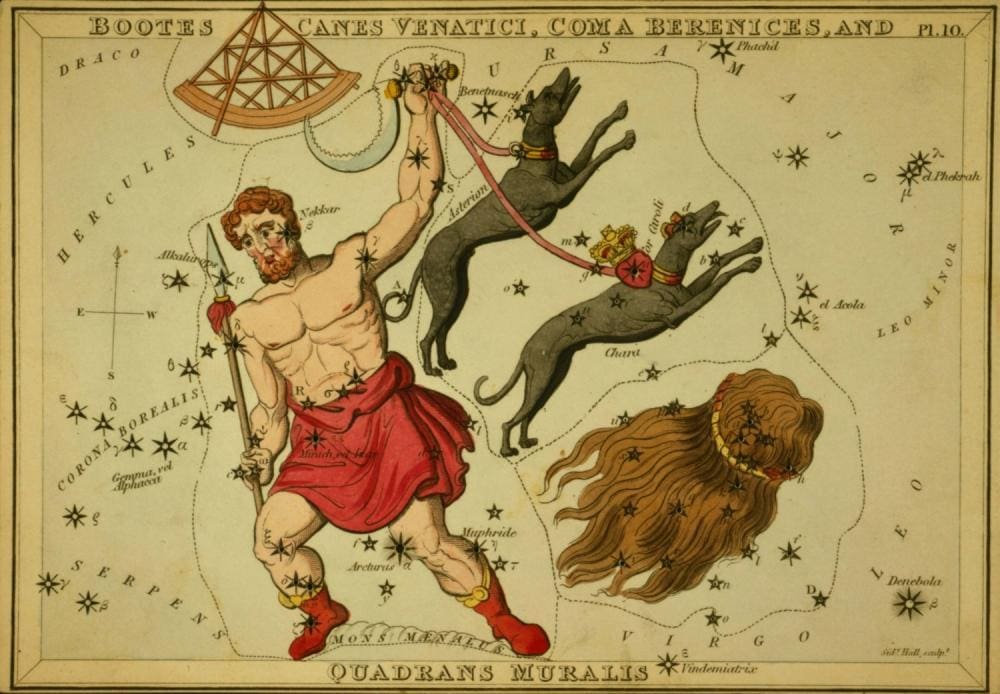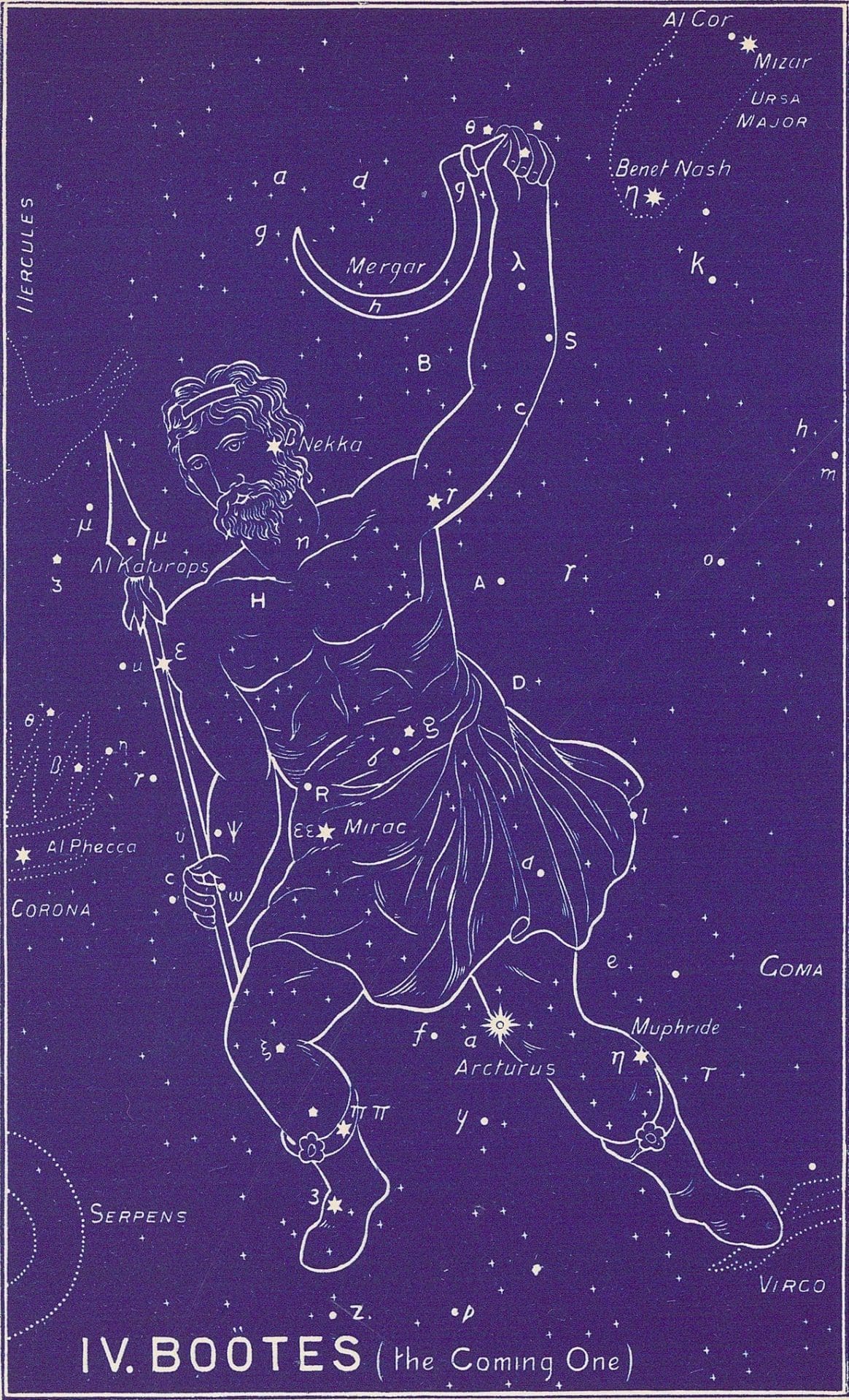Constellation Boötes the Herdsman is a northern constellation bordering Virgo, Serpens Caput, Corona Borealis, Hercules, Draco, Ursa Major, Canes Venatici, Coma Berenices and the obsolete constellations Mons Maenalus and Quadrans Muralis.
Boötes is one of the 48 constellations listed by Ptolemy in the 2nd century and remains one of the 88 modern constellations. It spans over 35 degrees of the zodiac in the Signs of Virgo, Libra and Scorpio.
Abbreviation: Boo
Genitive: Boötis
Constellation Boötes Stars
| 2000 | 2050 | Star | Name | Sp. Class | Mag. | Orb |
|---|---|---|---|---|---|---|
| 29♍58 | 00♎40 | κ2 Boo | Asellus Tertius | A8 | 4.53 | 1°10′ |
| 01♎06 | 01♎49 | ι Boo | Asellus Secundus | A9 | 4.75 | 1°00′ |
| 02♎37 | 03♎20 | θ Boo | Asellus Primus | F7 | 4.04 | 1°20′ |
| 06♎57 | 07♎40 | λ Boo | Xuange | A0 | 4.18 | 1°20′ |
| 12♎39 | 13♎22 | 39 Boo | F6 | 5.68 | 1°00′ | |
| 15♎27 | 16♎09 | 38 Boo | Merga | F7 | 5.76 | 1°00′ |
| 17♎40 | 18♎22 | γ Boo | Seginus | A7 | 3.04 | 1°50′ |
| 17♎47 | 18♎29 | i Boo | Quadrans | G2 | 4.83 | 1°00′ |
| 19♎20 | 20♎03 | η Boo | Muphrid | G0 | 2.68 | 2°00′ |
| 22♎47 | 23♎29 | ρ Boo | Hemelein Prima | K3 | 3.57 | 1°40′ |
| 23♎16 | 23♎59 | BP Boo | B9 | 5.48 | 1°00′ | |
| 23♎54 | 24♎36 | σ Boo | Hemelein Secunda | F3 | 4.47 | 1°10′ |
| 24♎14 | 24♎56 | α Boo | Arcturus | K2 | −0.05 | 2°40′ |
| 24♎15 | 24♎57 | β Boo | Nekkar | G8 | 3.49 | 1°40′ |
| 26♎28 | 27♎10 | 14 Boo | F6 | 5.53 | 1°00′ | |
| 27♎45 | 28♎27 | 18 Boo | F5 | 5.41 | 1°00′ | |
| 27♎47 | 28♎30 | 15 Boo | K1 | 5.29 | 1°00′ | |
| 28♎06 | 28♎49 | ε Boo | Izar | K0 | 2.37 | 2°10′ |
| 01♏51 | 02♏34 | π1 Boo | Alazal | B9 | 4.49 | 1°10′ |
| 03♏02 | 03♏44 | ζ Boo | A3 | 3.78 | 1°30′ | |
| 03♏09 | 03♏52 | δ Boo | Princeps | G8 | 3.46 | 1°40′ |
| 03♏10 | 03♏53 | μ1 Boo | Alkalurops | F0 | 4.31 | 1°10′ |
| 03♏30 | 04♏13 | ψ Boo | Aulad Alnathlat | K2 | 4.52 | 1°10′ |
| 03♏33 | 04♏15 | ξ Boo | G8 | 4.54 | 1°10′ | |
| 05♏06 | 05♏48 | φ Boo | Ceginus | G8 | 5.25 | 1°00′ |
| 05♏14 | 05♏56 | 31 Boo | G8 | 4.86 | 1°00′ |
39, 44, and BP of Boötes belonged to the obsolete constellation Quadrans Muralis.
β Boo is named Nekkar. Applied in recent times from a misreading of the Arabic constellation name al-baqqār, “the Ox-driver,” for Boötes. [1]
δ Boo is named Thiba in the image above, but astrologers used the word Princeps.
η Boo is named Muphrid. The formation of this name begins with the ancient Arabic name for α Boo: al-simāk al-rämih, “the Lance-bearing simāk” (the meaning of simāk is uncertain). It seems that later Arab poets expanded upon this name by making mention of some separate “lance” (al-rumh) that accompanied the star α Boo. Subsequent Arabs attempted to identify this fictitious lance with actual stars, sometimes saying it was η Boo with nearby stars, sometimes saying it was “η Boo alone,” (where “alone,” in Arabic is written mufradan). From these discussions came, with a slight copying mistake in the Arabic, the erroneous Arabic name mufrad al-rāmih, roughly translating as “the Isolated Single One of the Lance-bearer.” With a wrong vocalization and with abbreviation, this erroneous name, as “Muphrid,” was applied to η Boo in recent times. [1]
θ Boo has the traditional name Asellus Primus, Latin for “first donkey colt.”θ Boötis, along with the other Aselli (ι Boo and κ Boo) and λ Boo, were Aulād al Dhiʼbah (أولاد الضّباع – awlād al-ḍibā‘), “the Whelps of the Hyenas.” [2]
ι Boo is Asellus Secundus, “second donkey colt.”
κ Boo is Asellus Tertius, “third donkey colt.”
λ Boo has the Chinese name Xuange, from 玄戈 (Xuán Gē), meaning “Sombre Lance.” [3] With the Aselli (Boo, θ Boötis, ι Boo and κ Boo) it was one of the Aulād al Dhiʼbah (أولاد الضّباع – awlād al-ḍibā‘), “the Whelps of the Hyenas.” [2]
μ Boo is named Alkalurops. The formation of this name began with the words used by Ptolemy to describe this star in the Almagest: κολλóοοβος, “club,” rarely used as “shepherd’s staff.” This word was transliterated into Arabic as qulūrūbus, and hence into Laatin as calcurus. Then is Renaissance times, the derivation of calcurus was mistakenly attributed to another Greek word καλαύροψ, “shepherd’s staff.” This erroneous word, in its turn, was transliterated into Latin, then Arabicized with the article al-, then its spelling corrupted, to become “Alkalurops,” which thereafter applied as a star name to μ Boo. [1] μ Boo has also been known as Inkalunis (from the Alfonsine tables), Clava (Latin “the club”) and Venabulum (Latin “a hunting spear”). [2]
π Boo is called Alazal, but I can find no further information about it.
ρ Boo is named Hemelein Prima, meaning “first sheep.” From the Arabic الحملين al-ħamalayn meaning “two sheep,” and the word prima (first). [4]
σ Boo is Hemelein Secunda, “second sheep.”
φ Boo is named Ceginus. See γ Boo (Seginus).
ψ Boo is named Aulad Alnathlat or Nadlat. This star and another in the right arm, possibly ε Boo (Izar), constituted the Arabs’ Al Aulād al Nadhlāt, “the Low, or Mean, Little Ones.” However, Assemani rendered it filii altercationis (sons of contention). [2]
38 Boo is named Merga. A Latin word meaning “reaping hook, used in a Renaissance discussion of the constellation Boötes. According to this discussion, some classical sources mentioned a reaping hook held in Boötes’ hand opposite the staff. Subsequently the word applied as a star name to 38 Boo. [1]
Boötes Astrology
Manilius
True is the name men have given him (the Bearwarden), threatening-like he presses forward as one does over a team of bullocks. To those born under Arctophylax – Arcturus, fortune herself makes bold to entrust her treasures, so that the wealth of monarchs and temple finances will be in their keeping; they will be kings under kings and ministers of state, and be charged with the guardianship of the people or, as the stewards of grand houses, they will confine their business to the care of another’s home. [5]
Robson
Legend. Boötes is said to be Arcas, whose mother Callisto was transformed into a bear (see URSA MAJOR) by Juno. While hunting, Arcas came upon his mother unawares in her form of a bear and pursued her into the temple of Jupiter, where he would have killed her and afterward been killed himself by the priests. In order to prevent this, Jupiter, who had taken pity on them, took them both into heaven, where Boötes is still seen pursing the Bear. According to another account Boötes is Icarius, who was killed by some shepherds he had made drunk with a flagon of wine given him by Bacchus. In consideration of the grief of his daughter Erigone and their hound Mæra, Jupiter placed her father in heaven as Boötes, together with herself as Virgo and the hound as Canis Minor.
Influence. According to Ptolemy the influence of the constellation is like that of Mercury and Saturn, though the star Arcturus is like Mars and Jupiter. It is said to give prosperity from work, strong desires, a tendency to excess, a fondness for rural pursuits, together with some liking for occultism. The Kabalists associate it with the Hebrew letter Teth and the 9th Tarot Trump, “The Hermit”. [6]
Allen
the Italians’ Boote and the French Bouvier, is transliterated from Βοώτης, which appeared in the Odyssey, so that our title has been in use for nearly 3000 years, perhaps for much longer; although doubtless at first applied only to its prominent star Arcturus. Degenerate forms of the word have been Bootis and Bootres.
It has been variously derived: some say from Βοῦς, Ox, and ὡθεῖν, to drive, and so the Wagoner, or Driver, of the Wain; or the Ploughman of the Triones that, as Arator, occurs with Nigidius and Varro of the century before our era. But in recent times the figure has been imagined the Driver of Asterion and Chara in their pursuit of the Bear around the pole.
Others, and perhaps more correctly, thought the word Βοητής, Clamorous, transcribed as Boetes, from the shouts of the Driver to his Oxen, — the Triones, — or of the Hunter in pursuit of the Bear; Hevelius suggesting that the shouting was in encouragement of the Hounds.
The not infrequent title Herdsman, from the French Bouvier, also is appropriate, for not only was he associated with the Oxen of the Wain, but in Arab days the near-by circumpolar stars were regarded as a Fold with its inmates and enemies. Other names were Ἀρκτοφύλαξ and Ἀρκτοῦρος, the Bear-watcher and the Bear-guard.
Icarus, or Icarius, also was a title for our constellation, from the unfortunate Athenian who brought so much trouble into the world by his practical expounding of Bacchus’ ideas as to the proper use of the grape, and who was so unworthily exalted to the sky, with his daughter Erigone as Virgo, and their faithful hound Maera as Procyon or Sirius.
Boötes is a constellation of large extent, stretching from Draco to Virgo, nearly 50° in declination, and 30° in right ascension, and contains 85 naked-eye stars according to Argelander, 140 according to Heis. [2]
Bullinger
He is pictured as a man walking rapidly, with a spear in his right hand and a sickle in his left hand.
The Greeks called him Bo-o-tes, which is from the Hebrew root Bo (to come), meaning the coming.
It it probable that his ancient name was Arcturus (as referred to in Job ix. 9), for this is the name of the brightest star, α (in the left knee). Arcturus means He cometh.
The ancient Egyptians called him Smat, which means one who rules, subdues, and governs. They also called him Bau (a reminiscence of the more ancient Bo), which means also the coming one.
The star μ (in the spear-head) is named Al Katurops, which means the branch, treading under foot.
The star ε (just below the waist on his right side) is called Mirac, or Mizar, or Izar. Mirac means the coming forth as an arrow; Mizar, or Izar, means the preserver, guarding.
The star η is called Muphride, i.e. who separates.
The star β (in the head) is named Nekkar, i.e. the pierced (Zech. xii. 10), which tells us that this coming judge is the One who was pierced. Another Hebrew name is Merga, who bruises.
References
- A Dictionary of Modern Star Names, Kunitzch, Smart, 2006, p. 20-21.
- Star Names: Their Lore and Meaning, Richard H. Allen, 1889, p.92-106.
- List of Chinese Star Names – Wikipedia
- Rho Boötis – id.wikipedia.org
- Astronomica, Manilius, 1st century AD, book 5, p.329.
- Fixed Stars and Constellations in Astrology, Vivian E. Robson, 1923, p.32.
- The Witness of the Stars, E. W. Bullinger, 1893, BOÖTES (The Coming One).



Pluto conjunct Merga in 12th house exact. What’s the meaning of this???